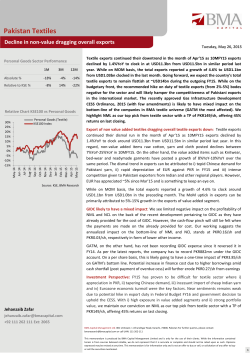
Middle class consumers - Canada West Foundation
DISCUSSION POINTS THE Feeding Global Middle Class April 22 – 23, 2015 Saskatoon, SK REDEFINING MIDDLE CLASS A new wave of consumers is changing the way we think about the middle class. They don’t drive SUVs or have flat screen TVs, but they have or will soon have enough money to aspire to a better life, make choices about what they consume and even dream about future purchases. Within 15 years, 3 billion people from around the globe will be added to this emerging middle class. Many of these people live in countries previously seen as overwhelmingly poor and in need of our charity rather than our exports. Our middle class paradigm is shifting as we consider the opportunities inherent in these new markets. DISPOSABLE INCOME + FINANCIAL SECURITY ABILITY TO CONSUME MORE & CONSUME DIFFERENTLY #fgmc2015 WE DEFINE THE GLOBAL MIDDLE CLASS AS THOSE WHO HAVE ENOUGH DISPOSABLE INCOME LEFT AFTER COVERING THE MINIMUM DAILY ESSENTIALS AND WHO FEEL SECURE ENOUGH ABOUT THEIR INCOME TO BEGIN TO CONSUME MORE AND CONSUME DIFFERENTLY. Growing Rapidly Earning More Truly Global 2.0 BILLION NOW 4.9 BILLION BY 2030 $10-$100 US/DAY While the largest growth will be in Asia and particularly China, significant opportunities exist in a wide range of countries – Malaysia, Vietnam, Chile and Mexico to name a few. A few of these countries already have trade agreements with Canada. (purchasing power parity) We can think of the GMC in two tiers: RISE OF THE GMC vs TOTAL POPULATION GROWTH 10 Total Population 8 6 GMC 4 2009 2020 Enough money and security to begin expanding the quantity and variety of goods consumed ($10-$22 US/DAY) Higher level of income and security enabling continued increase in discretionary spending, increased attention to quality (over $22 US/DAY) A third group which may be a market for some producers are the 2-3 BILLION people just emerging from poverty ($2-$10 US/DAY) 2 0 1 2 2030 Source: Brookings Institution Primarily Urban Consuming More The majority of people in the global middle class are moving to cities. As incomes rise, consumption increases and also changes. Universally, people want to expand and improve their diets, particularly consuming more protein, fats and oils. Families with the highest incomes spend markedly more on discretionary, high-value food categories. BY 2032, 173 CITIES WILL GROW TO POPULATIONS GREATER THAN 1 MILLION NUMBER OF CITIES BY SIZE CLASS OF URBAN SETTLEMENT 800 700 600 500 400 300 200 100 0 500,000 to 1 million 1 million to 5 million 10 million or more 5 to 10 million 1950 1970 Source: United Nations 1990 2010 2030 MIDDLE CLASS HOUSEHOLDS’ WEEKLY EXPENDITURES COMPARED TO THOSE WITH LOWER INCOMES Food Product Amount of Increase Fresh vegetables 2.85 Fresh fruit 3.19 Red meat 3.17 Poultry2.30 Fish & seafood 2.48 Yogurt, butter & cheese 4.55 Restaurants & bars 4.72 Candy & chocolate 8.50 Prepared foods (at home) 6.34 Alcoholic beverages 6.09 Source: Dr. Benjamin Senauer, University of Minnesota & Canada West Foundation IN ADDITION TO SIGNIFICANT INCREASES IN FOOD CONSUMPTION, THERE WILL BE A HUGE DEMAND FOR HARD COMMODITIES LIKE STEEL, COPPER AND WOOD AS CITIES GROW. More Dynamic & Diverse than Legacy Middle Class Markets Global middle class consumers will continue to improve their financial situation and move rapidly to higher levels of income and consumption. This adds to their value as potential consumers. CHILE 100 60 40 20 1975 1985 1995 2005 2015 2025 Europe Sub-Saharan Africa 2030 4.9 BILLION Central & South America Middle East & North Africa Source: Brookings Institution Impact & Opportunities INCREASED DEMAND FOR FULL RANGE OF COMMODITIES INCREASED COMPETITION AS OTHER COUNTRIES RAMP UP PRODUCTION TO MEET DEMAND INCREASED DEMAND FOR SPEED, QUALITY AND CERTAINTY OF DELIVERY NEED FOR IMPROVED COMMODITY PRODUCTION GLOBALLY CREATES A MARKET FOR WESTERN CANADA’S SERVICES AND TECHNOLOGY OPPORTUNITY TO ESTABLISH POSITIVE BRAND ASSOCIATION AND INFLUENCE DEVELOPMENT OF TASTES AND PREFERENCES IN KEY MARKETS VIETNAM 100 80 60 40 20 0 1965 North America Asia Pacific 2020 3.3 BILLION INCREASED DEMAND FOR EFFICIENT SUPPLY CHAINS WILL LEAD TO FURTHER CONSOLIDATION 80 0 1965 2009 1.8 BILLION 1975 $2-5/day 1985 1995 2005 2015 2025 $10-100/day Source: Brookings Institution As consumers experience more and more options, their tastes and preferences will also change rapidly, continuing to expand market opportunities. Markets will vary between countries, and even between cities within countries. Middle class consumers exist in large urban centres in regions with different cultures, tastes and local market dynamics. The high level of diversity will require both national and sub-national trade strategies. THE WEST HAS WHAT THE WORLD NEEDS TOP 5 EXPORTS FROM WESTERN CANADA TO CHINA, 2014, VALUE CD$ Vegetable products Chemical products Animal or vegetable fats and oils Wood pulp Machinery and electrical equipment 1,541,416,536 497,054,838 468,733,544 139,177,443 4,568,779 Source: Canada West Foundation calculations from Statistics Canada Annual growth in consumption in key GMC markets through 2050 averages 3.1% for food and 5.8% for housing and energy. The West’s top exports to China show strong alignment with areas of high demand in GMC countries. Feeding Global Middle Class THE # f g m c 2 015 How are we doing? When oil is removed, western Canada shows progress in diversifying exports beyond the U.S. While the percentage of total exports going to China and India has doubled in the last decade, there is significant room for continued growth in exports to these and other GMC countries. One example of this is Mexico where trade plateaued and recently decreased despite continued growth in the size of its GMC. ESTABLISHING POSITIVE BRAND ASSOCIATION PROTECTING REPUTATION DEVELOPING SOCIAL LICENCE STRENGTHENING INFRASTRUCTURE INCREASING COMPETITIVENESS WESTERN CANADIAN EXPORTS TO US & SELECT GMC COUNTRIES, 1990-2014 GROWING OUR UNDERSTANDING OF UNIQUE SUB-NATIONAL MARKETS 100 80 CONTINUING TO ENHANCE PRODUCT SELECTION AND QUALITY 60 40 LEVERAGING NEW MARKETS FOR OUR SERVICES AND TECHNOLOGY 20 0 What do we need to pay attention to? 1990 1995 2000 US % of total exports w/oil US % of total exports w/out oil China % total exports 2005 2010 2014 India % total exports Mexico % total exports Source: Canada West Foundation calculations from Statistics Canada QUESTIONS What’s the current state of alignment between global middle class opportunities and the West’s trade and export focus and capacity? What are the criteria that define a market as both advantageous and feasible to pursue? How might the consolidation of global food supply chains impact producers in western Canada? Should we be doing anything to respond or prepare? SPONSORS: ® Are we prepared to address international market concerns about food production and environmental impacts? Do we have the ability to advance and protect our brand? How can we identify and seize opportunities in services and technology? What steps do we need to take to ensure our trade infrastructure evolves to support our competitiveness?
© Copyright 2025


















